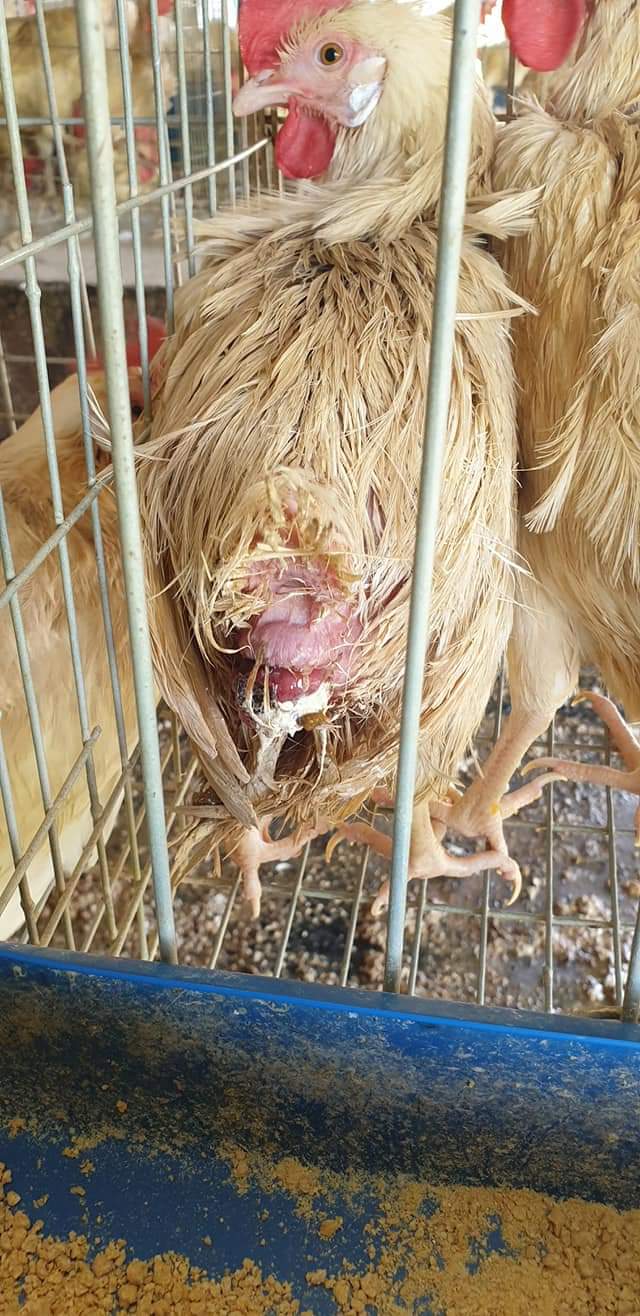PROLAPSE IN LAYERS
– PREVENTION AND TREATMENT
by-DR RAJESH KUMAR SINGH ,JAMSHEDPUR,JHARKHAND, INDIA,
9431309542,rajeshsinghvet@gmail.com.
Prolapse in laying hens is one, among the common diseases affecting laying chicken in the poultry farm that give concern to the poultry farmers or so called poultry keepers.
By definition, prolapse is a slipping forward or down of a part or organ of the body, this definition if according to oxford dictionary. Now that we talking about laying chicken the organ here is the eggs, so the improper position of eggs in laying chickens are term prolapse.
During the process of laying egg, the lower part of the chicken’s (layer(s)) reproductive track is temporarily turn inside out which lets the hen lay a very clean egg. Sometimes the tissue does not retract after the egg has been laid and this condition is referred to as a prolapse.
Prolapse during production is usually related to poor skeleton development during rearing, even if body weight during production is at target. In future, try to achieve upper limit of target weight from 4 to 8 weeks of age.
Prolapse (pickout) is the turning inside out of the oviduct and rectal organs through the vent, to the extent of not retracting back. Its occurrence may results in death. Its discovery in time will assist in the reposition of the organs back to their normal position using the hand.
What Causes Prolapse in chicken ?
Following is a summary of conditions where prolapse related problems are most likely to occur.
1. Overweight or underweight birds: Overweight birds are more susceptible to prolapse as a result of general muscle weakness and larger eggs laying tendency. Too much deposition of fat around reproductive organs exposes birds to prolapse.
2.Unbalanced feed rations: Insufficient calcium in the diet will bring challenges with eggshell formation but can also lead to muscle tone.
3.Reproductive age of the flock of birds: Prolapse occurs likely at the peak of birds’ production and period of peak egg mass, as a result of large demand placed on the birds’ metabolism.
4.Double-yolked eggs laying: The excessive size of these eggs will stretch and possibly weaken cloacal muscles.
5. High light intensity: Under high light intensity conditions, birds are more likely to see and be attracted to the everted oviduct and thus pecking occurs and cause damage.
Apart from this
the problem of oviduct prolapse in layer originated or start from growing and development stage, when the chicken/layer pelvic gardle is not well developed at rearing stage it results in prolapse, at times if the energy level in the feed is high more than required energy in feed, which results in high carbohydrate, it will cause prolapse in layer. High Fat content in feed will result in prolapse because, the accumulation of fat in the chicken abdominal region will narrow the egg passage and in the process of birds straining to push the egg out, it will results in prolapse. Excess Minerals/vitamins should be avoided to layers except before or after vaccination as antistress.
How to Prevent Prolapse in Chickens?—
The key to preventing prolapse is good management; and if good management is promptly applied, the effect of prolapse will be minimized, especially when syndrome begins to appear.
Major percentage of death recorded during the incidence of pickout/prolapse as ascribed to prolapse is not true.
The death is as a result of cannibalism among pullets through picking/pecking at the slightly inverted vent of another pullet when laying, till she loses blood or when the intestines have been damaged.
The sign observed during prolapse problem is the presence of blood-streaked eggs. As stated above, careful and serious management will reduce the rate of prolapse as well as most other health problems in the flock.
Isolation of affected birds should be done if possible to prevent further damage.
Note the following:
1.Photostimulation should occur when the birds reach the weight and age recommended by the breeder.
2. Balanced feed rations are required to sustain egg production and maintain body weight at recommended levels.
3. Ensure that light intensity in the pen house is at the breeder recommended level. Look into reducing the light intensity by covering windows, or replacing bulbs with lower watt bulbs.
If the flock is laying a lot (more than 4%) double-yolked eggs, gently restrict feed intake.
4. Birds should be watched to observe vent-pecking behaviour, and isolate such from the flock.
5. Pray the prolapsed vent with medicated spray such as oxytetravet spray.
. The following tips may help to reduce losses in this flock.
1. Do not exceed 16 hours light duration (better 15 hours). Also reduce light intensity (maximum 40 lux in open house, 20-30 lux in environment control house).
2. Adjust ME in feed to lower limit of recommendations.
3. Supplement Vitamin C @ 1 g/l drinking water in morning hours.
Steps 1 and 2 may slightly decrease egg produciton and egg size BUT you have to opt mortality or reduced production. Adopt these measures until 28 weeks of age.
Thereafter resume normal practices.
Several management problems in the rearing or laying of hens can be involved:
Hens being overweight.
Starting to increase the number of hours of light per day (photostimulation) before the pullet has reached the correct weight.
Feeding unbalanced diets.
Providing the hens with high-intensity light.
Hens that lay large double-yolked eggs are more prone to prolapse. Prolapse is also likely to occur at peak production.
There is no effective treatment for prolapse. Prevention is the best method of control.
Only photostimulate your pullets when they have reached the right body weight and age. This will vary from breed to breed but is typically around 17 weeks of age.
Feed only balanced feed rations specifically formulated for pullets and then layers.
Do not use high-intensity light. Chickens are more sensitive to light than humans, and excessive light can result in aggressive behavior.
If your flock is laying more than one double-yolked egg per 25 hens per day, reduce their daily feed consumption slightly.


